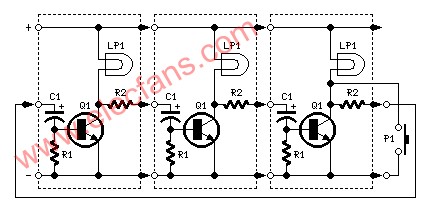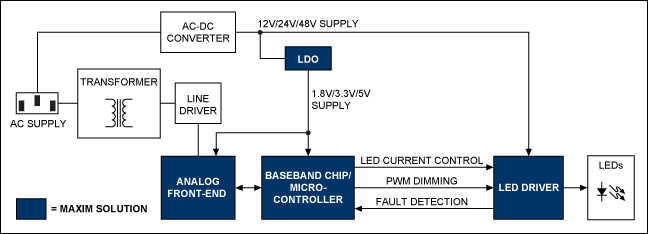LEDs for general lighting: what they offer and their design in retrofit lamps
This tutorial discusses the expanding role that light-emitting diodes (LEDs) are playing in general lighting applications. It compares LED performance versus other lighting technologies. It also analyzes the main challenges of designing LED lamps that retrofit existing lighting systems.
The expanding role for LED lighting
Light-emitting diodes (LEDs) are a rapidly evolving technology and are becoming viable for many general lighting applications, usually referred to as solid-state lighting. The most relevant examples of LED lighting applications are indoor uses in commercial, industrial, and residential environments; outdoor applications like street lights and parking lights; and architectural and decorative lighting where LEDs were initially adopted because of their ability to emit the whole spectrum of colors.
LEDs have been an effective solution for architectural lighting for some time. Today LEDs are penetrating the mainstream general lighting market, thanks to their higher performance compared to other lighting technologies:
- They have a much longer lifetime than other lighting technologies. LEDs can operate for 50,000 hours versus 1,000 to 2,000 hours for incandescent lamps and about 5,000 to 10,000 hours for compact fluorescent lights (CFLs). This markedly longer lifetime makes LEDs ideal for many commercial and industrial lighting applications where the labor cost to replace a lamp is high.
- Their energy efficiency is superior to incandescent and halogen lamps, and often equivalent to fluorescent lamps. Additionally, the efficacy of LEDs is continuously improving; the efficacy of white LEDs (WLEDs) is now forecasted to improve by about 50% over the next three to four years.
- They have a small form factor. LEDs fit in some form factors like MR16 and GU10 lamps where CFLs do not.
- They can be dimmed with the appropriate driver. Fluorescent lamps pose technical limitations when the application requires dimming. Although conventional LED designs have encountered similar issues, innovative LED drivers from Maxim are compatible with triac and trailing-edge dimmers.
- They emit a very directional light. Unlike other lighting technologies, LEDs are more appropriate for applications like narrow-angle reflector lamps that require a very directional light.
- Their efficacy improves at lower temperatures. The efficacy of fluorescent lamps degrades at lower temperatures. In contrast, LEDs are ideal for applications with a low ambient temperature like refrigerator lighting.
- It is very easy to change the color of their emitted light. This makes RGB LEDs ideal for applications like architectural and mood lighting where the color of the light must change in real time.
In summary, LEDs offer many advantages over incandescent lamps and fluorescent lamps. Consequently, designers continue to find more applications for LED lighting, but that discussion could consume us for a long while. This review will focus on one LED lighting application: LED retrofit lamps, which replace incandescent, halogen, or fluorescent lamps in the same socket. These LED lamps must fit in the existing form factor and be compatible with the existing infrastructure.
LED retrofit lamps
Many would argue that the LED retrofit lamp market is the fastest growing application for LED lighting today. The reason for this fast growth is actually quite straightforward: these lamps do not require a new electrical infrastructure (i.e., cabling, transformers, dimmers, and sockets), a significant advantage for LED technology.
PAR20 product photo courtesy of LEDtronics, Inc.
LuxDot™ photo courtesy of LedEngin™, Inc.
Fitting an LED lamp into the existing infrastructure challenges the designer in two principal ways:
- The form factor. Retrofit lamps must fit in the form factor of the previous light source.
- Electrical compatibility. Retrofit lamps must work correctly and without light flicker in the existing electrical infrastructure.
We shall discuss each challenge in turn.
Fitting the existing form factor
The existing form factor imposes both a physical limitation (i.e., the driver board has to be small enough) and a thermal limitation on a retrofit lamp. These limitations pose challenges for the design of a replacement lamp (e.g., PAR, R, and A form factors), challenges that are particularly hard to overcome for smaller form factors like MR16 and GU10.
While size is important for a retrofit, thermal limitation is often more critical. LEDs emit only visible light; they do not irradiate energy at infrared wavelengths like other technologies. Thus while LEDs are more energy efficient than incandescent or halogen lamps, they dissipate much more heat through thermal conduction in the lamp.
Thermal dissipation is also the main limiting factor for the amount of light that a lamp can produce. Today's LED technology in retrofit lamps can barely achieve a level of brightness that is acceptable for the mainstream market. Pushing the limits of brightness and, consequently, thermal design are essential for designing a commercially successful product.
A corollary issue to the thermal dissipation is the lifetime of the driver board. To emit more light, the lamp must work at a fairly high temperature (+80°C to +100°C). At these temperatures, the lifetime of the driver board can limit the operation of the whole lamp. Electrolytic capacitors are, in particular, the biggest challenge. Since they dry quickly at those temperatures, the operation of those capacitors is limited to no more than a few thousand hours, and this becomes the limiting factor for the whole lamp. Since longevity is a major selling point for LED lamps, managing the relatively short lifetime of electrolytic capacitors is a major issue for the lamp designer.
Maxim has developed unique LED solutions for both 120VAC/230VAC input and 12VAC input retrofit lamps. These LED solutions do not require electrolytic capacitors on the board. This extends the lifetime of the lamp from typically less than 10,000 hours to up to 90,000 hours. Not having electrolytic capacitors also reduces the size of the solution, so the driver board fits the small retrofit form factor.
Matching the electrical infrastructure
Retrofit LED lamps must work correctly in infrastructures that include cut-angle (triac or trailing-edge) dimmers and electronic transformers.
Working off the 120VAC/230VAC line, the lamp can be preceded by a triac dimmer. Triac dimmers are designed to work well with incandescent and halogen lamps, which are perfectly resistive loads. With LED retrofit lamps, however, the LED driver is generally a very nonlinear and not purely resistive load; its input bridge rectifier typically draws brief, high-intensity peaks of current when the AC input voltage is at its positive and negative peaks. This LED behavior does not allow the triac dimmer to work properly, because it provides neither the needed start current nor the hold current. As a result, the dimmer does not start properly or turns off while operating, and the LED lamp light flickers in an unacceptable way.
The electrical infrastructure is even more complicated for 12VAC input lamps, because an electronic transformer and trailing-edge dimmer can be connected at the lamp's input. Again, a 12VAC input lamp driver that uses the traditional bridge rectifier and DC-DC converter topology flickers because of incompatibility with the transformer and dimmer.
Maxim's LED solutions for 120VAC/230VAC and 12VAC input lamps use a single-stage conversion. By shaping the input current so that the light does not flicker even when dimmed, these solutions are compatible with triac and trailing-edge dimmers and electronic transformers. No other solutions for MR16 lights offer this feature; few solutions for PAR, R, and A lamps offer it. In addition, these solutions provide better than 0.9 power-factor correction and require a very limited number of external components. No electrolytic capacitors are required, which considerably extends the lifetime of the driver circuit working in a hot environment. Both the 120VAC/230VAC and 12VAC solutions employ the MAX16834 IC, and are available for evaluation and use in mass production. They are both proprietary to Maxim, which is the only supplier to provide this combination of advantages.
Block diagram for MR16 (top) and offline (bottom) lamps.
 电子发烧友App
电子发烧友App

































评论